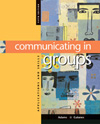Synchronous and Asynchronous CMC Businesses and organizations are increasingly using CMC as a method of communication.
One way to classify types of CMC is to determine whether the communication is
synchronous or asynchronous. With synchronous communication members interact
in real time, and each participant is simultaneously a sender and a receiver.
With asynchronous communication delays occur in the communication interaction,
and each participant must take turns being the sender and receiver. What are
some reasons groups might use both synchronous and asynchronous communication? A common form of CMC used by many organizations is electronic mail, or e-mail.
E-mail is asynchronous communication because this medium does not allow for
interactive, real-time communication between people. Although e-mail does not
have the advantage of being synchronous communication, e-mail is a cheap and
efficient method for communicating with other Internet users. A study conducted
by communication researchers at UCLA found that on average, 76 percent of people
with e-mail capability check for messages on a daily basis. E-mail is quickly becoming one of the most cost-efficient methods of communication.
Most colleges and universities provide students with free e-mail accounts. In
addition, those with access to the Internet may obtain free e-mail accounts
through any number of online services. Examples of free e-mail providers include: Hotmail.com Yahoo.com SOURCE: "Surveying the Digital Future" [Internet],
UCLA Internet Report, UCLA Center for Communication Policy, 2000. Available:
http://www.ccp.ucla.edu. | 


 2003 McGraw-Hill Higher Education
2003 McGraw-Hill Higher Education